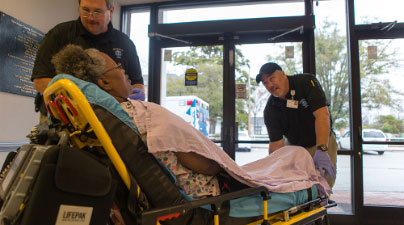Lone workers have always existed in some industries, such as utilities and transportation. But with the increasing popularity of remote and work-from-home positions in a variety of other fields, the number of lone workers is increasing.
While there are benefits of working alone, such as increased flexibility and independence, there are also downsides. Specifically, lone workers often face unique threats to their safety and well-being. Corporations have a duty of care for all employees, but that responsibility can be particularly important when it comes to lone workers. Employers can protect lone workers’ physical and mental health by maintaining regular contact and providing them with reliable, accessible methods of communication.
What is a lone worker?
The Occupational Safety and Health Administration (OSHA) defines a lone worker as an employee who is “working alone, such as in a confined space or isolated location.” There are lone workers in many industries: utilities, transportation, manufacturing, security, forestry, agriculture and even retail.
Information from International Data Corporation (IDC) indicates that there were over 96 million mobile workers (i.e., those who work outside of a physical office location) in the U.S. in 2015, a number that was projected to grow to 105.4 million by 2020. The IDC estimates that mobile workers may account for as much as 73% of the U.S. workforce.
Many mobile workers have jobs where they work alone. There aren’t any official government statistics that show the number of lone workers in the U.S. However, some experts estimate that there are as many as 53 million lone workers in North America and Europe, which is approximately 15% of the overall workforce.
Common examples of activities for lone workers
Many lone workers operate in dangerous or stressful environments. Remote jobs may also happen during nontraditional working hours (e.g., nighttime security).
Working in remote locations
Many lone workers spend their days away from colleagues and managers; sometimes, they are alone for their entire shift. Utilities installation and maintenance, appliance repair, house cleaning and surveying are just a few examples of occupations that require employees to work by themselves in remote locations.
Many healthcare professionals are considered lone workers if they provide in-home care. Caregivers are often alone with their patients and may feel isolated from colleagues, especially if they experience stressful incidents on the job (e.g., a patient injuring themself or dying).
Working from home
Advances in technology have allowed employees in many industries to perform their jobs from home using a smartphone or computer with internet access. Remote work offers many benefits, but it also requires companies to find ways to engage their workers in meaningful conversation and team-building activities. Managers must also be able to monitor and support remote workers’ mental health.
Mobile-based work
There are many lone workers in transportation jobs. For example, taxi and ride-share drivers don’t generally interact with anyone other than clients. Truck drivers and delivery persons also spend much of their working time alone. Mobile workers may move in and out of the range of cell phone and internet coverage.
Off-hours work
Lone security guards often work outside of traditional business hours. They may not interact with colleagues or clients at all during their shifts. Retail workers may also work nontraditional hours, especially if they are employed in gas stations and convenience stores.
Challenges lone workers face
Working alone can threaten an employee’s physical safety and mental well-being. Lone workers are vulnerable to physical confrontations and attacks, especially when working in remote locations.
Statistics show that lone workers are often victims of workplace violence. The CDC reports that from 2015 to 2019, over one-fifth of workplace homicide victims worked in sales/retail occupations (e.g., gas station or convenience store clerks). During the same time period, gas station attendants and taxi drivers experienced some of the highest average victimization rates of nonfatal workplace violence: 59.4 per 1,000 workers, and 45.4 per 1,000 workers, respectively.
Employees who work alone may not receive notifications about severe weather, illness exposure or localized law enforcement activity as quickly as employees who are surrounded by others. Additionally, working alone for long periods can negatively affect mental health. Data from the UK shows that 64% of lone workers face psychological distress, a rate which is significantly higher than that reported by employees who don’t work alone.
Communication solutions to protect lone workers
OSHA recognizes the unique challenges of working alone and places several requirements on employers of lone workers. Employers must monitor a lone worker’s safety and health by checking in at regular intervals during each shift and at the end of a workday or a project.
OSHA regulations allow employers to account for lone workers via either sight or verbal communication. In-person check-ins are impractical in many situations, which makes other forms of communication especially important for corporations with lone workers.
Remote or mobile job sites may not provide access to reliable forms of traditional communication, such as telephones and pagers. In these circumstances, employers must find other ways to ensure that they can monitor and support with lone workers. Rave Mobile offers several communication solutions to help employers maintain connections with workers in any location.
Location monitoring
It’s crucial for employers to know where their employees are, especially those who work alone in off-site or remote locations. With Rave AppArmor, employers can quickly and easily connect with workers anywhere. The virtual escort feature allows a user to set departure and arrival times and will automatically notify designated guardians when the user reaches their destination or misses their arrival time.
The app features integrated confidential texting, allowing employees to report suspicious activity or safety concerns without fear of reprisal. Administrators can also utilize geo-targeted alerts to notify employees in certain areas, ensuring they are warned of severe weather or law enforcement activity in their location.
Wellness and status checks
Managers may not see their lone workers very often, making it difficult to spot the signs of physical or mental illness. With two-way communication tools, such as status checks or polls, managers can reach out to lone workers to verify their well-being. By initiating conversions about morale and wellness, employers can fulfill their OSHA requirements and discourage employees from ignoring or hiding signs of stress, illness or dissatisfaction.
Emergency notifications
Lone workers often need to be informed of crisis situations that happen at an office, warehouse or “home base.” Integrating a mass notification system with on-site emergency infrastructure (e.g., fire alarms, PA systems or emergency shutdown mechanisms) ensures that all workers will receive critical alerts regardless of their location.
The Rave Alert mass notification solution allows users to send alerts to targeted groups via multiple channels: email, voice, SMS text, social media and push notifications. Multimodal messaging improves the chances that remote workers receive alerts in a timely manner.
Mobile panic app
A mobile panic app is one of the most effective ways to keep lone workers safe. Many lone workers don’t have ready access to landline telephones or contact details for internal incident managers.
With the Rave Panic Button, users can contact 9-1-1 and alert designated administrators of an emergency with just a few taps of their smartphone. The app features prebuilt templates for common crises, including medical emergencies, fires and active shooter events. First responders automatically receive critical details, including the type of activation and the user’s location, and can use integrated communication features to request status updates and live video of the incident.
Keep lone workers safe and connected
Lone workers are vital members of the workforce, but working alone presents unique challenges that employers must address. Remote workers must have reliable ways to connect with managers and colleagues so they can ask questions, get clarification, receive information and report emergencies. A communication system for lone workers needs multichannel functionality and integrated tools that allow employers to verify an employee’s physical safety, morale and mental health.
The Rave Mobile Safety Suite provides a range of communication solutions designed to meet the unique challenges affecting lone workers and their employers. From mass notification systems to custom-branded safety apps, we offers tools to improve communication during daily operations and crisis situations. Choose from prebuilt tools or work with our team to create a customized solution. Contact us to get started.





Comments are closed here.